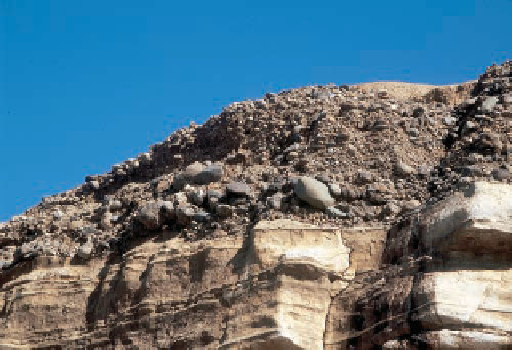Geology Reference
In-Depth Information
◗
Figure 6.19
Detrital and Sedimentary Rocks
a
A layer of conglomerate overlying sandstone. The largest clast
measures about 30 cm across.
b
Sedimentary breccia in Death Valley, California. Notice the
angular gravel-sized particles. The largest clast is about 12 cm
across.
c
Exposure of shale in Tennessee.
(Figure 6.18). Varieties include
siltstone
(mostly silt-sized
particles),
mudstone
(a mixture of silt and clay), and
claystone
(primarily clay-sized particles). Some mudstones and clay-
stones are designated
shale
if they are fi ssile, meaning that they
break along closely spaced parallel planes (Figure 6.19c). Even
weak currents transport silt- and clay-sized particles, and depo-
sition takes place only where currents and fl uid turbulence are
minimal, as in the quiet offshore waters of lakes or in lagoons.
composed of fragmented seashells. Organisms play an
important role in the origin of chemical sedimentary rocks
designated
biochemical sedimentary rocks
.
Limestone and dolostone, the most abundant chemical
sedimentary rocks, are known as
carbonate rocks
because
each is made up of minerals that contain the carbonate radical
(CO
3
-2
). Limestone consists of calcite (CaCO
3
), and dolostone
is made up of dolomite [CaMg(CO
3
)
2
] (see Chapter 3). Recall
that calcite rapidly dissolves in acidic water, but the chemi-
cal reaction leading to dissolution is reversible, so calcite can
precipitate from solution in some circumstances. Thus, some
limestone, though probably not very much, forms by inorganic
chemical precipitation. Most limestone is biochemical because
organisms are so important in its origin—the rock in coral
reefs and limestone composed of seashells, for instance
(
Sedimentary Rocks
Several compounds and ions taken into solution during
chemical weathering are the raw materials for
chemical
sedimentary rocks
. Some of these rocks have a
crystalline
texture
, meaning they are composed of a mosaic of inter-
locking mineral crystals as in rock salt. Others, though,
have a clastic texture; some limestones, for instance, are
◗
Figure 6.20a, b).
A type of limestone composed almost entirely of frag-
mented seashells is known as
coquina
(Figure 6.20c), and






Search WWH ::

Custom Search